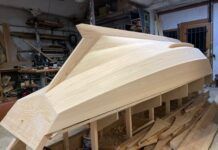A lot of boats depend on a large Edson diaphragm pump as a last ditch emergency pump. Pumps are either permanently mounted or bolted to a board stowed at the bottom of a locker. Edson pumps are very simple and very expensive-about $300 list for the aluminum 18-gallon-per-minute model, and about $500 for the 30-gallon-per-minute model, more in bronze. Theyre probably the best you can buy. One expects them to work in an emergency.
Last spring, Bill Seifert of Warren, Rhode Island, who manages a fleet of expensive yachts for their owners, dropped by the office with a failed Edson pump.
Along with the pump he gave us this report:
Last winter I used the large Edson #638 aluminum bottom inlet pump on the 54′ ketch Cloud Shadow to remove bilge water. As I pumped, I noted increasing leakage from the diaphragm. I bought a new diaphragm. Only after removing the pump top mechanism was the cause for leakage evident. The pump uses stainless steel axles in aluminum castings, which were corroded and almost immovable. Leverage of the 32 handle allowed me to pump, but the pivot on top of the diaphragm was locked solid, causing undue pressure on the diaphragm.
I tried heating the axles red hot with torches, then allowing them to cool, but an hours efforts did not budge them. I took the top to Edson, who was unable to force out the axles with a hydraulic press. Edson sold me a new top pivot assembly and admonished me to keep the axles lubricated, and to inspect the pump often. I also bought new valve flappers, figuring it was time to rebuild the 1986 vintage pump. On this bottom inlet pump the intake flapper valve is affixed with two 1/2-20 SS bolts tapped into the aluminum body. One bolt sheared off as I tried to remove it. Under the flapper I found the aluminum pump housing badly pitted, with most of the valve seat corroded away. Small wonder the pump would not hold a prime. The boat manufacturer had screwed a bronze tail piece into the aluminum pump, which caused the degradation.
Back to Edson for a new pump body, then a stop at a plumbing supply for schedule 80 PVC fittings for a new tail piece. I used a 1-1/2 IPS PVC nipple as a hose barb, as proper pipe-to-hose adapters are not available in 2. (See PS Riprap, September 1998.) I smeared a lot of Tef-Gel on the SS bolts holding the bottom flapper in place. Under the side outlet valve, I found the aluminum pump badly pitted from sea water. I bedded the new flapper valve perimeter, hoping to keep water from the machined valve mounting face.
With the new diaphragm and pivots lubricated liberally with Tef-Gel, I was able to operate the pump by grabbing the handle socket. I plan to make close annual inspection of Edson pumps on all the yachts I manage, and urge readers to do likewise.
As any saltwater sailor knows, corrosion caused by dissimilar metals is a constant headache. Where possible, insulating the aluminum and stainless steel with a non-conductive material, such as plastic, prevents future problems.
In the case of the Edson pump, one wonders why a nylon or Delrin bushing could not be used. To find out, we asked Will Keene of Edson for his opinion. He told us that such a bushing would quickly wear out.
Regarding Cloud Shadows corroded pump, he said it was his understanding that the pump had been stowed for 11 years. Edson literature, he said, recommends at least semi-annual inspection and operation. Equipment likes to be used, he said.
We agree.







































